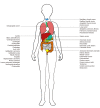Carbohydrate antigen 19-9 - tumor marker: Past, present, and future
- PMID: 33437400
- PMCID: PMC7769746
- DOI: 10.4240/wjgs.v12.i12.468
Carbohydrate antigen 19-9 - tumor marker: Past, present, and future
Abstract
Carbohydrate antigen 19-9 (CA 19-9) is a cell surface glycoprotein complex most commonly associated with pancreatic ductal adenocarcinoma (PDAC). Koprowski first described it in 1979 using a mouse monoclonal antibody in a colorectal carcinoma cell line. Historically, it is one of the most commonly used tumor markers for diagnosing, managing, and prognosticating PDAC. Additionally, elevated CA 19-9 levels are used as an indication for surgery in suspected benign pancreatic conditions. Another common application of CA 19-9 in the biliary tract includes its use as an adjunct in diagnosing cholangiocarcinoma. However, its clinical value is not limited to the hepatopancreatobiliary system. The reality is that the advancing literature has broadened the clinical value of CA 19-9. The potential value of CA 19-9 in patients' workup extends its reach to gastrointestinal cancers - such as colorectal and oesophageal cancer - and further beyond the gastrointestinal tract - including urological, gynecological, pulmonary, and thyroid pathologies. Apart from its role in investigations, CA 19-9 presents a potential therapeutic target in PDAC and acute pancreatitis. In a bid to consolidate its broad utility, we appraised and reviewed the biomarker's current utility and limitations in investigations and management, while discussing the potential applications for CA 19-9 in the works for the future.
Keywords: Biliary tract diseases; Carbohydrate antigen 19-9 antigen; Gastrointestinal diseases; Liver diseases; Pancreatic diseases; Pancreatic neoplasms.
©The Author(s) 2020. Published by Baishideng Publishing Group Inc. All rights reserved.
Conflict of interest statement
Conflict-of-interest statement: Authors declare no conflict of interests for this article.
Figures
References
-
- Scarà S, Bottoni P, Scatena R. CA 19-9: Biochemical and Clinical Aspects. Adv Exp Med Biol. 2015;867:247–260. - PubMed
-
- Goh BK, Tan YM, Thng CH, Cheow PC, Chung YF, Chow PK, Wong WK, Ooi LL. How useful are clinical, biochemical, and cross-sectional imaging features in predicting potentially malignant or malignant cystic lesions of the pancreas? J Am Coll Surg. 2008;206:17–27. - PubMed
-
- Kajbafzadeh AM, Elmi A, Talab SS, Emami H, Esfahani SA, Saeedi P. Urinary and serum carbohydrate antigen 19-9 as a biomarker in ureteropelvic junction obstruction in children. J Urol. 2010;183:2353–2360. - PubMed
-
- Dyckhoff G, Warta R, Gonnermann A, Plinkert PK, Flechtenmacher C, Volkmann M. Carbohydrate antigen 19-9 in saliva: possible preoperative marker of malignancy in parotid tumors. Otolaryngol Head Neck Surg. 2011;145:772–777. - PubMed
Publication types
LinkOut - more resources
Full Text Sources
Miscellaneous


